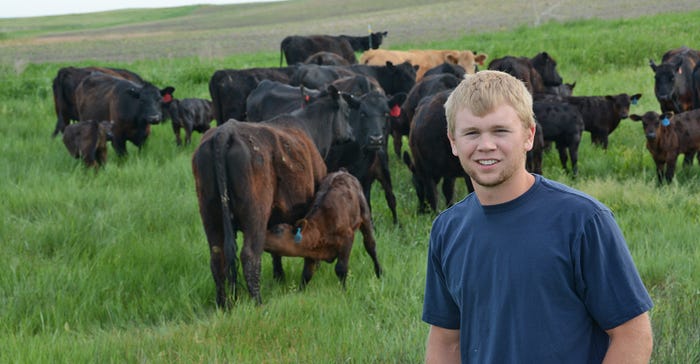July 31, 2017

Where there’s a will to farm, there’s a way farm. Justin Zahradka is proof. He’s getting his start farming by custom grazing and backgrounding calves.
Zahradka, 23, of Lawton, N.D., grew up on a small farm. His parents, Jeff and Lori, both work off the farm. They ran a few stock cows, which is what sparked Zahradka’s interest in livestock. In 2008, while still in junior high, he bought his first bred heifer with an FFA Supervised Agricultural Experience grant. In 2011, when he was a high school junior, he rented some cropland coming out of the Conservation Reserve Program. He planted cover crops on it and grazed it, and was even part of a county Extension demonstration project measuring the daily rate of gain on the cattle.
Zahradka continued custom grazing while attending North Dakota State University. He graduated with a major in crop and weed science and a minor in soil science. He worked as a crop scout for three summers while he was in college and did it full time for a year after he graduated from NDSU. But he always felt the pull of the farm. He wanted to be an entrepreneur.
Good combination
Custom grazing, backgrounding calves and raising a few acres of cash grain has been a good combination for Zahradka. To get started farming, he didn’t have to invest a lot of money upfront in land, cattle or equipment. Of the 185 cow-calf pairs he grazes, he only owns 16, which he bought in the spring of 2017. He found enough cows to custom graze by simply running an ad on Bisman List, an online classified ad site. He buys calves to background from college friends. Last winter he fed out 170 calves.
Zahradka’s crop machinery lineup consists of a 1981 JD 4440 tractor, a 20-foot-wide John Deere 750 no-till drill and a 90-foot pull-behind Summers sprayer. He has purchased a large round baler and uses his dad’s sickle mower and rakes to put up hay. He has grain crops custom-harvested.
Zahradka’s livestock equipment is minimal. In addition to the haying equipment and tractor, he has a feed mixer wagon, pickup, cattle trailer, dump trailer and ATV. He’s rigged up the ATV to haul fencing materials.
His parents’ farmstead has pens where he backgrounds calves and winters cows. He feeds the animals a ration of alfalfa, straw corn and sugarbeet pulp. He hauls the beet pulp to the farm from American Crystal’s Drayton, N.D., factory 45 miles away.
Increased production
Zahradka has used some progressive grazing practices to increase forage production, which has made it possible to increase the stocking rate and graze longer than is typical on the Northern Plains.
He plants cover crops after harvesting his cash grain crops (winter rye, spring wheat, field peas or canola) and then either grazes them in the fall or the following spring.
He uses an intensive grazing management system rather a traditional season-long grazing system. His goal is to move cows and their calves every three or four days to new grass.
“I am trying to move them before they take the second bite off the grass,” he says.
Zahradka uses a single-strand electric polywire to fence off paddocks and moves the fence when he moves cattle. It takes about three hours to fence 30 acres.
He has a Fence Alarm App on his smartphone that sends him text alerts when there’s a short on electric fence. The app is handy because some of the pastures are 20 miles from home.
Right choice
Zahradka says he probably could make more money in the short term working off the farm than farming full time, but he likes what he is doing and figures that he will be able to grow the business in the future.
“Farming,” he says, “is the right choice for me.”
You May Also Like




